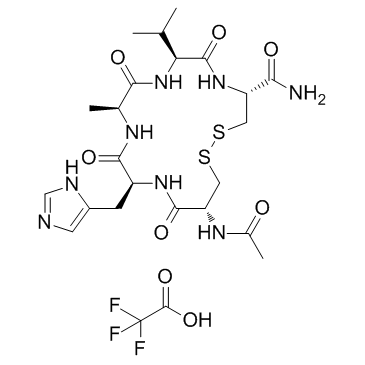1135237-88-5
| Name | (4R,7S,10S,13S,16R)-16-acetamido-13-(1H-imidazol-5-ylmethyl)-10-methyl-6,9,12,15-tetraoxo-7-propan-2-yl-1,2-dithia-5,8,11,14-tetrazacycloheptadecane-4-carboxamide,2,2,2-trifluoroacetic acid |
|---|---|
| Synonyms |
ADH-1 Peptide trifluroacetate
ADH-1 trifluroacetate UNII-4OJ57R316O Exherin (trifluoroacetate) |
| Description | Exherin trifluoroacetate is an N-cadherin antagonist, which inhibits N-cadherin mediated cell adhesion. |
|---|---|
| Related Catalog | |
| In Vitro | Exherin (0.2 mg/mL) blocks collagen I-mediated changes in pancreatic cancer cells, and is highly effective at preventing cell motility that is induced by expression of N-cadherin. Exherin (0, 0.1, 0.2, 0.5 and 1.0 mg/mL) induces apoptosis in a dose-dependent and N-cadherin-dependent manner[1]. |
| In Vivo | Exherin (50 mg/kg) significantly prevents tumor growth and metastasis in a mouse model for pancreatic cancer. Exherin prevents tumor cell invasion and metastasis in an orthotopic model for pancreatic cancer using N-cadherin overexpressing BxPC-3 cells[1]. Exherin, at the dosages evaluated, does not display either antiangiogenic activity in a rat aortic ring assay or antitumor potential in a PC3 subcutaneous xenograft tumor model[2]. Exherin (10 mL/kg, i.p.) augmentation of melanoma tumor growth is overcome through its ability to make regionally infused melphalan more effective. Exherin mediated augmentation of melanoma tumor growth is not altered by regionally infused temozolomide. In A375, but not DM443 xenografts, Exherin treatment increases phosphorylation of AKT at serine 473. Exherin slightly diminishes N-cadherin expression in both xenografts[3]. |
| Animal Admin | Animals are anesthetized, and 40 μL of a single cell suspension containing 50,000 cells is injected into the pancreas. Mice are randomized into treatment groups 10 days after surgery. For treatment, mice are injected intraperitoneally once per day with Exherin at 50 mg/kg in 100 μL PBS (×1 per day, ×5 per week for 4 weeks). For in vivo bioluminescence, D-Luciferin is administered by intraperitoneal injection. Data are acquired 20 min after injection using the IVIS system. Tumor growth is monitored every 10 days from day 10 to day 50 after surgery. Luciferase activity is quantified using the IVIS system. Two months after surgery, the mice are killed, and the pancreas, liver, lung, and disseminated nodules are harvested, fixed in 10% buffered formalin, and embedded in paraffin. Serial 5-μM sections are cut, mounted on slides, and stained with H&E using standard procedures. Sections are also stained for TUNEL. Sections are examined using a Zeiss Axioscop 40 microscope equipped with an AxioCam MR digital camera and software. |
| References |
| Molecular Formula | C24H35F3N8O8S2 |
|---|---|
| Molecular Weight | 684.70900 |
| Exact Mass | 684.19700 |
| PSA | 323.61000 |
| LogP | 1.67920 |
| Storage condition | 2-8℃ |
